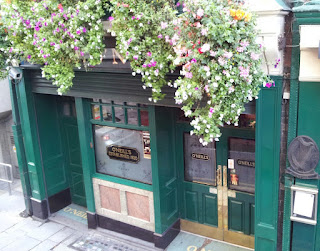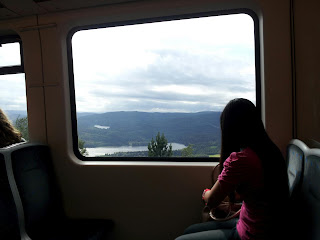Just a short flight away from the UK, what better way to get a flavour of Ireland than from its most populous city, and capital.
Stemming from a small Viking settlement, 'Black Pool' has evolved, often turbulantly, into the vibrant and cosmopolitan city it is today. With refreshingly little idea of what to expect, I spend a few days finding out what Dublin has to offer.
Promptly arriving by bus in O'Connell Street, I am a little surprised at the scale and grandeur of the buildings; the street is wide and flourishing with activity - very much a central hub. I pass the well cared-for Parnell monument on the way to my hotel, imposingly positioned facing the length of the street, asserting a proud gaze over Dublin. It's clear already that politics are close to Dublin's heart.
It is in fact just off Parnell Square where my hotel is situated. The Maldron Hotel I conclude, was a good choice - very well appointed, and ideally situated. After passing some typically Irish red-brick and brown Georgian buldings, this 'Irish' palette of colour is reflected in the decor of the room.
I hop on a bus departing from O'Connell street, which promises informative commentary and a 'hop on hop off' tour of the city. The most omnipresent sight as the bus travels towards the General Post Office is the Spire of Dublin, launching into the sky seemingly for miles. A modern day obelisk constructed of steel, the spire simply works, quite unexpectedly, as a beacon for prosperity and freedom reaching towards the clouds.
The spire complements the grand Georgian General Post Office building well. The GPO has served as much more than a post office in Dublin's past, incuding the headquarters for the leaders of the brutal Easter Uprising in 1916.
At the other end of the street, the O'Connell monument stands proud as if serving to protect, as well as displaying the ubiquitous harp of Ireland as seen on the Parnell monument, adding to an overall sense of a 'grand plan', or uniformity for O'Connell Street.
Many more characteristically tall red-brick houses are to be seen; they are rapidly becoming a defining feature of Irish architecture as the bus continues on. One of them is covered in a dressing of bright green and red ivy; quite surreal.
A curious, rather pleasant yeasty smell announces that the bus is nearing the Guinness Storehouse, further confirmed by the very loud bus tour commentary. As the bus turns and begins to navigate through the factory grounds, past the enormous brick and industrial buildings, I ponder the Irish influences on American architecture - perhaps Boston or New York spring to mind.
Inisde, the beautiful old qualities of the interior have been preserved and fused with modern attributes. Old iron beams and brick walls give way to the worlds largest 'pint glass', consisting of a glass tower centre, surrounded by various levels - each telling the story of Guinness, its history and heritage.
Learning about every ingredient and every process that goes into Guinness is thirsty work - it's time to have a hand in pouring my own pint. In a very informative session, I join other tourists in being trained how to pour the perfect pint of Guinness; I am even given a certificate to prove it. Of course I am also allowed to 'sample' my perfect pint afterwards...
Well and truely a converted Guinness drinker, I leave to board the bus again. My next stop will be Kilmainham Gaol: a long decommissioned prison built in the 18th century.
A sense of grim forboding is evoked as soon as I set foot outside its grey, cold walls. A serpent-esque motif above the main entrance marks the gateway to a once hellish place of incarceration.
Damp, chilling and musty air surrounds me as I am led around with a group, by a very enthusiastic tour guide. The squalid spaces feel alive again as I am told of how hundreds of men, women and children would have been crammed inside. Furthermore, the guide states that the conditions inside the prison around the 1850s were more more favourable than those outside; crimes would be committed intentionally in order to be locked-up here.
Peering into the cells, only a small amount of light is visible from tiny windows, high above the confined, maddening rooms. I am told stories in relation to particular cells as I move through - mostly of unfortunate political prisoners and other more romanticised tales.
The Parnell name crops up again as the group moves into his old cell; the difference is astonishing, with a fireplace, windows and relative luxury of a separate living room and sleeping area. The story goes that Parnell, being a political prisoner in times where he had immense Irish support, was treated royally so as not to cause unrest outside the prison walls. Luxury meals, spacious private quarters and guards catering for his every whim - a very strange predicament indeed.
Stepping into the 'new' Victorian wing feels like a refreshing breakthrough, at least in comparison to the squalid concrete cells I had first seen. The prison opens up into a multi-story atrium with natural light from high above. Wrought iron staircases wind up to the various levels. Inside the cells, a marked improvement awaits with substantial windows, and cleaner, brighter rooms. This area followed the Victorian trend, or rather realisation that prisoners benefited, in terms of psychological behaviour, from exposure to daylight. Still a morbid, claustrophobic place, but a huge step up from the earlier wings.
The tour concludes with the outside area, most notably the courtyard where the executions took place. I stare up at the high stone walls, and wonder if they had any glimmer of hope for a chance of escape. Poignant crosses mark the spots of the actual killings; very stirring indeed.
I breathe a sign of relief as I am 'released' from Kilmainham through the heavy iron doors.
The next morning I head to a much cheerier place: Dublin Zoo. On route, the bus passes through Pheonix Park, which, as I am informed by the commentary, is many times bigger than New York's Central Park. With endless forest and hills in the background, it really is a tranquil haven. The Wellington Monument towers high above the trees - the second largest obelisk in the world, after Washington's.
Continuing the 'American' reminiscence, I see the white gates to the US Embassy, sporting the USA flag, and opposite, the gated entrance to the President's home. An obscure opportune glance through the trees reveals something very similar to the White House.
Dublin Zoo has a reputation as one of Europe's finest, and it doesn't disappoint. The habitats are fantastically spacious, yet afford up-close views of each animal without fail as if they knew I was coming. I also seem to stumble upon each enclosure at feeding time; the elephants, chimpanzees and sea lions show off their manners at dinner time. A baby tapir and even a baby giraffe are highlights.
I finish the evening with a hearty Irish meal in a typical Irish pub, where a feeling of warmness and Irish good will is extended.
Even at 4am, the taxi driver taking me to the airport the following morning is almost unnaturally talkative and friendly - it seems to be customary for the Irish to treat even strangers as though they are familiar friends. I notice the many independent shops, bars and restaurants flourishing in Dublin; quite a contrast to much of the UK, where national and global companies are quickly becoming a majority. Possibly the openness and hospitality of the Irish is a reason for these shops survival - not to mention the overcoming prosperity of the Irish themselves.
I leave Dublin with a good taste in my mouth - not just from the Guinness, but a warming and unique taste from a very liberal and sociable city.















































